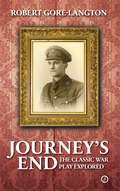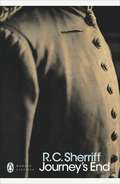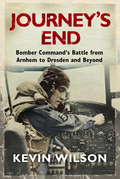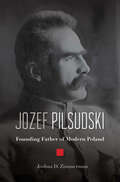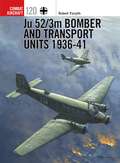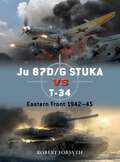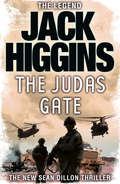- Table View
- List View
Journey into the Land of the Zeks and Back: A Memoir of the Gulag
by Julius MargolinUnder the Soviet regime, millions of zeks (prisoners) were incarcerated in the forced labor camps, the Gulag. There many died of starvation, disease, and exhaustion, and some were killed by criminals and camp guards. In 1939, as the Nazis and Soviets invaded Poland, many Polish citizens found themselves swept up by the Soviet occupation and sent into the Gulag. One such victim was Julius Margolin, a Pinsk-born Jewish philosopher and writer living in Palestine who was in Poland on family matters. Margolin's Journey into the Land of the Zeks and Back offers a powerful, first-person account of one of the most shocking chapters of the violent twentieth century. Opening with the outbreak of World War II in Poland, Margolin relates its devastating impact on the Jews and his arrest and imprisonment in the Gulag system. During his incarceration from 1940 to 1945, he nearly died from starvation and overwork but was able to return to Western Europe and rejoin his family in Palestine. With a philosopher's astute analysis of man and society, as well as with humor, his memoir of flight, entrapment, and survival details the choices and dilemmas faced by an individual under extreme duress. Margolin's moving account illuminates universal issues of human rights under a totalitarian regime and ultimately the triumph of human dignity and decency. This translation by Stefani Hoffman is the first English-language edition of this classic work, originally written in Russian in 1947 and published in an abridged French version in 1949. Circulated in a Russian samizdat version in the USSR, it exerted considerable influence on the formation of the genre of Gulag memoirs and was eagerly read by Soviet dissidents. Timothy Snyder's foreword and Katherine Jolluck's introduction contextualize the creation of this remarkable account of a Jewish world ravaged in the Stalinist empire--and the life of the man who was determined to reveal the horrors of the gulag camps and the plight of the zeks to the world.
Journey Out of Darkness: The Real Story of American Heroes in Hitler's POW Camps--An Oral History (Praeger Security International)
by Hal LaCroix Jorg MeyerJourney Out of Darkness is a poignant collection of portraits, in words and photographs, of 19 former prisoners of war who bravely endured captivity in Nazi Germany in World War II. Through these men, one can learn essential truths about the POW experience during that war—truths that counter many popular myths and misconceptions. The men featured here gather every week in offices of the Veterans Administration in Boston and Brockton, Mass. to talk about their experiences and find comfort in each other. In their eighties and nineties, they are unique individuals with unique wartime experiences, but also representative of the more than 120,000 American POWs held in Nazi Germany. They are men who fought a double war, in combat and then as POWs. Using both oral histories and photographs to tell their stories, LaCroix and Meyer humanize a terrifying aspect of war, redefining how we think about these men as POWs, survivors, patriots, and members of the Greatest Generation.Journey Out of Darkness is a poignant collection of portraits, in words and photographs, of 19 former prisoners of war who bravely endured captivity in Nazi Germany during World War II. Through these men, one can learn essential truths about the POW experience during that war—truths that counter many popular myths and misconceptions.The 19 men featured here gather every week in offices of the Veterans Administration in Boston and Brockton, Mass., to talk about their experiences and find comfort in each other. In their eighties and nineties, they are unique individuals with unique wartime experiences, but also representative of the more than 120,000 American POWs held in Nazi Germany. They are men who fought a double war, in combat and then as POWs. Together, their photos and their stories go beyond typical first-person accounts.Until the men in this book began meeting in VA support groups, few had spoken of their POW experiences. Some were told by the military not to talk; others were coerced by military intelligence into signing non-disclosure papers called security certificates. With little exception, they received no recognition for enduring as POWs, even as they struggled with traumatic memories and shame for having been held captive, for losing power over their fate, and for surviving combat when friends died. These portraits also illuminate another little-known story: the plight of Jewish-American POWs. Two of the men featured in the book were Jews who concealed their religious identities from the SS.LaCroix and Meyer have crafted a powerful exploration of the struggles of these brave veterans. Using both oral histories and photographs, Journey Out of Darkness humanizes a terrifying aspect of war, redefining how we think about these men as POWs, survivors, patriots, and members of the Greatest Generation.
Journey's End: The Classic War Play Explored (Oberon Modern Plays)
by Robert Gore-LangtonR C Sherriff’s Journey’s End is a syllabus text and the most famous play about World War One. First staged in 1928, this book tells the story of what went into the making of this extraordinary and powerful trench drama. It outlines Sherriff’s career from humble insurance clerk to infantry officer and his unforgettable 10 months on the western front before he was invalided home, lucky to be alive. Sherriff poured into his first professional play his personal experience of living in a front-line dug-out. Using his diary and letters home, the book charts his emotional life under fire and relates it directly to the play, its events and its characters. It also tells the story of Journey’s End’s incredible box office success across the world, a triumph which made its shy young author famous overnight.Taking in the history of the show right up to the most recent productions, Journey’s End: The Classic War Play Explored is a meditation on Journey’s End’s achievement as a war document, its fascination for audiences when it was first staged and its continuing grip on theatregoers and students today.
Journey's End (Penguin Modern Classics)
by R. C. SherriffSet in the First World War, Journey's End concerns a group of British officers on the front line and opens in a dugout in the trenches in France. Raleigh, a new eighteen-year-old officer fresh out of English public school, joins the besieged company of his friend and cricketing hero Stanhope, and finds him dramatically changed ...Laurence Olivier starred as Stanhope in the first performance of Journey's End in 1928; the play was an instant stage success and remains a remarkable anti-war classic.
Journey's End: Bomber Command's Battle from Arnhem to Dresden and Beyond
by Kevin Wilson'A brilliant insight into life in the air and on the ground' ObserverIn February 1945, British and American bombers rained down thousands of tons of incendiaries on the city of Dresden, killing an estimated 25,000 people and destroying one of the most beautiful cities in Europe. The controversy that erupted shortly afterwards, and which continues to this day, has long overshadowed the other events of the bomber war, and blighted the memory of the young men who gave their lives to fight in the skies over Germany.Journey's End neither condemns nor condones the bombing of Dresden, but puts it in its proper context as part of a much larger campaign. To the young men who flew over Germany night after night there were other much more pressing worries: the V2 rockets that threatened their loved ones at home; the brand new German jet fighters that could strike them at speeds of over 600mph. They lived life at a heightened tempo during these final unforgiving months of the bomber war when no quarter was given on either side.As the climactic volume in Kevin Wilson's acclaimed bomber war trilogy, Journey's End chronicles the brutal endgame of a conflict that caused such devastation and tragedy on both sides.
Joystick Soldiers: The Politics of Play in Military Video Games
by Nina B. Huntemann Matthew Thomas PayneJoystick Soldiers is the first anthology to examine the reciprocal relationship between militarism and video games. War has been an integral theme of the games industry since the invention of the first video game, Spacewar! in 1962.While war video games began as entertainment, military organizations soon saw their potential as combat simulation and recruitment tools. A profitable and popular relationship was established between the video game industry and the military, and continues today with video game franchises like America’s Army, which was developed by the U.S.Army as a public relations and recruitment tool. This collection features all new essays that explore how modern warfare has been represented in and influenced by video games. The contributors explore the history and political economy of video games and the "military-entertainment complex;" present textual analyses of military-themed video games such as Metal Gear Solid; and offer reception studies of gamers, fandom, and political activism within online gaming.
Joystick Soldiers: The Politics of Play in Military Video Games
by Nina B. Huntemann Matthew Thomas PayneJoystick Soldiers is the first anthology to examine the reciprocal relationship between militarism and video games. War has been an integral theme of the games industry since the invention of the first video game, Spacewar! in 1962.While war video games began as entertainment, military organizations soon saw their potential as combat simulation and recruitment tools. A profitable and popular relationship was established between the video game industry and the military, and continues today with video game franchises like America’s Army, which was developed by the U.S.Army as a public relations and recruitment tool. This collection features all new essays that explore how modern warfare has been represented in and influenced by video games. The contributors explore the history and political economy of video games and the "military-entertainment complex;" present textual analyses of military-themed video games such as Metal Gear Solid; and offer reception studies of gamers, fandom, and political activism within online gaming.
Jozef Pilsudski: Founding Father of Modern Poland
by Joshua D. ZimmermanThe story of the enigmatic Jozef Pilsudski, the founding father of modern Poland: a brilliant military leader and high-minded statesman who betrayed his own democratic vision by seizing power in a military coup. In the story of modern Poland, no one stands taller than Jozef Pilsudski. From the age of sixteen he devoted his life to reestablishing the Polish state that had ceased to exist in 1795. Ahead of World War I, he created a clandestine military corps to fight Russia, which held most Polish territory. After the war, his dream of an independent Poland realized, he took the helm of its newly democratic political order. When he died in 1935, he was buried alongside Polish kings. Yet Pilsudski was a complicated figure. Passionately devoted to the idea of democracy, he ceded power on constitutional terms, only to retake it a few years later in a coup when he believed his opponents aimed to dismantle the democratic system. Joshua Zimmerman’s authoritative biography examines a national hero in the thick of a changing Europe, and the legacy that still divides supporters and detractors. The Poland that Pilsudski envisioned was modern, democratic, and pluralistic. Domestically, he championed equality for Jews. Internationally, he positioned Poland as a bulwark against Bolshevism. But in 1926 he seized power violently, then ruled as a strongman for nearly a decade, imprisoning opponents and eroding legislative power. In Zimmerman’s telling, Pilsudski’s faith in the young democracy was shattered after its first elected president was assassinated. Unnerved by Poles brutally turning on one another, the father of the nation came to doubt his fellow citizens’ democratic commitments and thereby betrayed his own. It is a legacy that dogs today’s Poland, caught on the tortured edge between self-government and authoritarianism.
Ju 52/3m Bomber and Transport Units 1936-41 (Combat Aircraft)
by Jim Laurier Robert Forsyth Mark PostlethwaiteThe all-metal Junkers Ju 52/3m enjoyed a solid – indeed, revered – reputation amongst its crews and the troops and paratroopers who used and depended on it. For more than ten years, it saw service as a successful military transport, with its distinctive, three-engined design and corrugated metal construction becoming instantly recognisable. It was a mainstay in the Luftwaffe's inventory, first seeing service in the 1930s in bombing and transport operations in the Spanish Civil War, and subsequently during the German invasion of Poland. It then served on every front on which the Luftwaffe was deployed until May 1945. The Junkers served as a stalwart transport, confronting both freezing temperatures and ice, and heat and dust, lifting men, animals, food and supplies vital for German military operations. This, the first of two books on the Ju 52/3m, details its service as a bomber in Spain and in South America, followed by its pivotal role in early war operations during the invasions of Poland and France, the airborne invasion of Crete and the early stages of Operation Barbarossa.
Ju 52/3m Bomber and Transport Units 1936-41 (Combat Aircraft #120)
by Jim Laurier Robert Forsyth Mark PostlethwaiteThe all-metal Junkers Ju 52/3m enjoyed a solid – indeed, revered – reputation amongst its crews and the troops and paratroopers who used and depended on it. For more than ten years, it saw service as a successful military transport, with its distinctive, three-engined design and corrugated metal construction becoming instantly recognisable. It was a mainstay in the Luftwaffe's inventory, first seeing service in the 1930s in bombing and transport operations in the Spanish Civil War, and subsequently during the German invasion of Poland. It then served on every front on which the Luftwaffe was deployed until May 1945. The Junkers served as a stalwart transport, confronting both freezing temperatures and ice, and heat and dust, lifting men, animals, food and supplies vital for German military operations. This, the first of two books on the Ju 52/3m, details its service as a bomber in Spain and in South America, followed by its pivotal role in early war operations during the invasions of Poland and France, the airborne invasion of Crete and the early stages of Operation Barbarossa.
JU 87 Stuka Dive Bomber (large print)
by RnibThis page shows two images of an aircraft. At the top of the page seen from the side and in the bottom and middle of the page a plan view seen from above. There is a locator dot shown, which will be at the top left of the page when the image is the correct way up. Both views have the front on the left and the tail on the right of the page. The aircraft is shown in a flying position. The aircraft in the top of the page has the propeller on the left with one blade pointing up and one pointing down. The tip of the nose cone is yellow on the large print image. Up and right there is a notch in the fuselage, this is the air intake for the engine. Down from this is a rectangle which comprises six exhaust outlets. The bottom left of the front of the aircraft nose has a notch. This is the air intake for the radiator. To the right, down from the exhaust, are outlets for hot air to escape. In the top centre of the image is the cockpit cover. It has an aerial sticking up. Poking up and right is a gun the rear gunner would use if the aircraft was attacked. Down from the cockpit is the wingtip and mainly underside of the wing. The wings on this aircraft are angled down a short way as they leave the fuselage. They then kink upwards towards the tip of the wing, allowing the underside to be found. One of the two front wheels is shown down from the wing. The wheel is largely hidden by the streamlined wheel cover. A single large bomb is attached under the cockpit between the wheels. The leg of the wheel hides the central part of the bomb. Right of the wing the fuselage continues to the vertical tail fin on the right. In the centre of this section is a cross identifying the plane as German. In the centre of the fin is the end of one of the tail wings. Right of this is a vertical flap. This is one of the ailerons used to manoeuvre the aircraft when it is flying. Down from the fin is the single small tail wheel. In the plan view image in the bottom and middle of the page the fuselage goes from left to right in the centre of the image. The main wings go up and down the page from the fuselage. In the left of the page the propeller has one blade pointing up and one pointing down. The tip of the nose cone is yellow on the large print image. To the right of the propeller six exhaust outlets can be found on the top and bottom edge of the fuselage. Right of this are the wings. On the wings near the fuselage there is a horizontal line which is where the wing kinks. Towards the tips of each wing there is a cross identifying the plane as German. The trailing edge of the wings on the right has flaps which are the automatic airbrakes used to take the aircraft out of a dive so it does not crash. In the centre of the fuselage between the wings is the cockpit. The fuselage continues to the right ending in the tailplane. On the right of each tail wing is a flap. These are two of the ailerons used to manoeuvre the aircraft when it is flying.
JU 87 Stuka Dive Bomber (UEB contracted)
by RnibThis page shows two images of an aircraft. At the top of the page seen from the side and in the bottom and middle of the page a plan view seen from above. There is a locator dot shown, which will be at the top left of the page when the image is the correct way up. Both views have the front on the left and the tail on the right of the page. The aircraft is shown in a flying position. The aircraft in the top of the page has the propeller on the left with one blade pointing up and one pointing down. The tip of the nose cone is yellow on the large print image. Up and right there is a notch in the fuselage, this is the air intake for the engine. Down from this is a rectangle which comprises six exhaust outlets. The bottom left of the front of the aircraft nose has a notch. This is the air intake for the radiator. To the right, down from the exhaust, are outlets for hot air to escape. In the top centre of the image is the cockpit cover. It has an aerial sticking up. Poking up and right is a gun the rear gunner would use if the aircraft was attacked. Down from the cockpit is the wingtip and mainly underside of the wing. The wings on this aircraft are angled down a short way as they leave the fuselage. They then kink upwards towards the tip of the wing, allowing the underside to be found. One of the two front wheels is shown down from the wing. The wheel is largely hidden by the streamlined wheel cover. A single large bomb is attached under the cockpit between the wheels. The leg of the wheel hides the central part of the bomb. Right of the wing the fuselage continues to the vertical tail fin on the right. In the centre of this section is a cross identifying the plane as German. In the centre of the fin is the end of one of the tail wings. Right of this is a vertical flap. This is one of the ailerons used to manoeuvre the aircraft when it is flying. Down from the fin is the single small tail wheel. In the plan view image in the bottom and middle of the page the fuselage goes from left to right in the centre of the image. The main wings go up and down the page from the fuselage. In the left of the page the propeller has one blade pointing up and one pointing down. The tip of the nose cone is yellow on the large print image. To the right of the propeller six exhaust outlets can be found on the top and bottom edge of the fuselage. Right of this are the wings. On the wings near the fuselage there is a horizontal line which is where the wing kinks. Towards the tips of each wing there is a cross identifying the plane as German. The trailing edge of the wings on the right has flaps which are the automatic airbrakes used to take the aircraft out of a dive so it does not crash. In the centre of the fuselage between the wings is the cockpit. The fuselage continues to the right ending in the tailplane. On the right of each tail wing is a flap. These are two of the ailerons used to manoeuvre the aircraft when it is flying.
JU 87 Stuka Dive Bomber (UEB uncontracted)
by RnibThis page shows two images of an aircraft. At the top of the page seen from the side and in the bottom and middle of the page a plan view seen from above. There is a locator dot shown, which will be at the top left of the page when the image is the correct way up. Both views have the front on the left and the tail on the right of the page. The aircraft is shown in a flying position. The aircraft in the top of the page has the propeller on the left with one blade pointing up and one pointing down. The tip of the nose cone is yellow on the large print image. Up and right there is a notch in the fuselage, this is the air intake for the engine. Down from this is a rectangle which comprises six exhaust outlets. The bottom left of the front of the aircraft nose has a notch. This is the air intake for the radiator. To the right, down from the exhaust, are outlets for hot air to escape. In the top centre of the image is the cockpit cover. It has an aerial sticking up. Poking up and right is a gun the rear gunner would use if the aircraft was attacked. Down from the cockpit is the wingtip and mainly underside of the wing. The wings on this aircraft are angled down a short way as they leave the fuselage. They then kink upwards towards the tip of the wing, allowing the underside to be found. One of the two front wheels is shown down from the wing. The wheel is largely hidden by the streamlined wheel cover. A single large bomb is attached under the cockpit between the wheels. The leg of the wheel hides the central part of the bomb. Right of the wing the fuselage continues to the vertical tail fin on the right. In the centre of this section is a cross identifying the plane as German. In the centre of the fin is the end of one of the tail wings. Right of this is a vertical flap. This is one of the ailerons used to manoeuvre the aircraft when it is flying. Down from the fin is the single small tail wheel. In the plan view image in the bottom and middle of the page the fuselage goes from left to right in the centre of the image. The main wings go up and down the page from the fuselage. In the left of the page the propeller has one blade pointing up and one pointing down. The tip of the nose cone is yellow on the large print image. To the right of the propeller six exhaust outlets can be found on the top and bottom edge of the fuselage. Right of this are the wings. On the wings near the fuselage there is a horizontal line which is where the wing kinks. Towards the tips of each wing there is a cross identifying the plane as German. The trailing edge of the wings on the right has flaps which are the automatic airbrakes used to take the aircraft out of a dive so it does not crash. In the centre of the fuselage between the wings is the cockpit. The fuselage continues to the right ending in the tailplane. On the right of each tail wing is a flap. These are two of the ailerons used to manoeuvre the aircraft when it is flying.
Ju 87 Stuka vs Royal Navy Carriers: Mediterranean (Duel)
by Robert ForsythJu 87 dive-bombers, originally developed for pin-pointing bombing missions against land targets and Allied naval vessels were deployed by both the Luftwaffe and the Regia Aeronautica against the Allied forces. Included in such a target were perhaps the greatest prize of all for a Stuka pilot: a British aircraft carrier.This superbly illustrated book looks at the duel between the Ju 87 Stuka and the aircraft carriers of the Royal Navy. Despite their gun protection ('pompoms')and their squadrons of fighters, these immense and mighty vessels proved irresistible targets to determined and experienced Stuka aces as they endeavoured to stop British naval intervention in the campaigns in Norway, Malta and Crete. By 1941, the Ju 87 had become known by the British as a fearsome aircraft following its operations in France, specifically at Dunkirk, as well as in the Balkans. For the Luftwaffe, it was an aircraft in which they still had great confidence despite its mauling in the Battle of Britain during the summer of 1940. This book examines the key attributes and shortcomings of both aircraft and carrier by analysing various compelling episodes including the dramatic attacks on Ark Royal by Stukageschwader (St.G) 1 off Norway in April 1940, the strikes by the Luftwaffe's St.G 1, St.G 2 and the Regia Aeronautica's 237° Squadriglia against Illustrious in Malta harbour. Aside from outstanding photography and artwork, this volume also include numerous personal accounts from Stuka crews, the pilots of carrier-borne fighters opposing them and the sailors embarked in the various carriers that came under attack.
Ju 87 Stuka vs Royal Navy Carriers: Mediterranean (Duel)
by Robert ForsythJu 87 dive-bombers, originally developed for pin-pointing bombing missions against land targets and Allied naval vessels were deployed by both the Luftwaffe and the Regia Aeronautica against the Allied forces. Included in such a target were perhaps the greatest prize of all for a Stuka pilot: a British aircraft carrier.This superbly illustrated book looks at the duel between the Ju 87 Stuka and the aircraft carriers of the Royal Navy. Despite their gun protection ('pompoms')and their squadrons of fighters, these immense and mighty vessels proved irresistible targets to determined and experienced Stuka aces as they endeavoured to stop British naval intervention in the campaigns in Norway, Malta and Crete. By 1941, the Ju 87 had become known by the British as a fearsome aircraft following its operations in France, specifically at Dunkirk, as well as in the Balkans. For the Luftwaffe, it was an aircraft in which they still had great confidence despite its mauling in the Battle of Britain during the summer of 1940. This book examines the key attributes and shortcomings of both aircraft and carrier by analysing various compelling episodes including the dramatic attacks on Ark Royal by Stukageschwader (St.G) 1 off Norway in April 1940, the strikes by the Luftwaffe's St.G 1, St.G 2 and the Regia Aeronautica's 237° Squadriglia against Illustrious in Malta harbour. Aside from outstanding photography and artwork, this volume also include numerous personal accounts from Stuka crews, the pilots of carrier-borne fighters opposing them and the sailors embarked in the various carriers that came under attack.
Ju 87D/G STUKA versus T-34: Eastern Front 1942–45 (Duel #129)
by Robert ForsythAn examination of two of the most high-profile air and land weapons to be deployed on the Eastern Front in World War II.In late 1942, as part of its attempts to strike back at ever-increasing numbers of Soviet tanks, the German air ministry authorised the development of an adaptation and enhancement of the longspan Junkers Ju 87D-5 Stuka dive-bomber. The aircraft was duly fitted with two underwing pods containing 37 mm BK cannon – an antiaircraft cannon with its origins dating back to 1933. The solid, slow, Ju 87 airframe offered the Luftwaffe an ideal platform for specialist, low level, 'tank-killing' operations. Despite the wealth of experience possessed by some of the Luftwaffe's ground-attack and dive-bomber aces, knocking out T-34 tanks from the air was a demanding and difficult process. Nevertheless, some Luftwaffe pilots notched up impressive tank scores, and the Ju 87 is credited with the destruction of more than 100 tanks across the central and southern sectors of the Eastern Front, including during the Battle of Kursk. Including personal accounts from Stuka pilots and biographies of the anti-tank aces, together with detailed photographs of the cannon installation into the Ju 87G and details of the construction of the T-34 illustrated using specially commissioned artwork, this book covers the epic clash of two legendary machines of World War II.
Ju 87D/G STUKA versus T-34: Eastern Front 1942–45 (Duel #129)
by Robert ForsythAn examination of two of the most high-profile air and land weapons to be deployed on the Eastern Front in World War II.In late 1942, as part of its attempts to strike back at ever-increasing numbers of Soviet tanks, the German air ministry authorised the development of an adaptation and enhancement of the longspan Junkers Ju 87D-5 Stuka dive-bomber. The aircraft was duly fitted with two underwing pods containing 37 mm BK cannon – an antiaircraft cannon with its origins dating back to 1933. The solid, slow, Ju 87 airframe offered the Luftwaffe an ideal platform for specialist, low level, 'tank-killing' operations. Despite the wealth of experience possessed by some of the Luftwaffe's ground-attack and dive-bomber aces, knocking out T-34 tanks from the air was a demanding and difficult process. Nevertheless, some Luftwaffe pilots notched up impressive tank scores, and the Ju 87 is credited with the destruction of more than 100 tanks across the central and southern sectors of the Eastern Front, including during the Battle of Kursk. Including personal accounts from Stuka pilots and biographies of the anti-tank aces, together with detailed photographs of the cannon installation into the Ju 87G and details of the construction of the T-34 illustrated using specially commissioned artwork, this book covers the epic clash of two legendary machines of World War II.
Ju 88 Aces of World War 2 (Aircraft of the Aces)
by Jim Laurier Robert Forsyth Mark PostlethwaiteInitially designed as a fast medium bomber, the Junkers Ju 88 was also used as a Zerstörer heavy fighter by the Luftwaffe. It saw its combat debut over Poland in 1939, and heavy fighter variants saw action on every front up to VE Day. The ultimate Ju 88 fighter variant was the G-model of 1944, which boasted a FuG 220 or 227 radar, an astounding array of cannon and machine gun armament and advanced Junkers Jumo or BMW engines. A dedicated nightfighter, the first Ju 88G-1s entered service with the Nachtjagd in the summer of 1944, replacing Ju 88C/Rs as well as some Bf 110Gs. Despite suffering heavy losses in the final months of the war, Ju 88Gs also inflicted serious casualties on Bomber Command throughout the war.From patrolling over the Bay of Biscay, to the Arctic circle opposing Allied convoys and, most successfully, as radar-equipped nightfighters engaging RAF heavy bombers during defence of the Reich operations from late 1941, this is the story of the Ju 88 aces who menaced Allied aircraft and shipping throughout World War 2.
Ju 88 Aces of World War 2 (Aircraft of the Aces #133)
by Jim Laurier Robert Forsyth Mark PostlethwaiteInitially designed as a fast medium bomber, the Junkers Ju 88 was also used as a Zerstörer heavy fighter by the Luftwaffe. It saw its combat debut over Poland in 1939, and heavy fighter variants saw action on every front up to VE Day. The ultimate Ju 88 fighter variant was the G-model of 1944, which boasted a FuG 220 or 227 radar, an astounding array of cannon and machine gun armament and advanced Junkers Jumo or BMW engines. A dedicated nightfighter, the first Ju 88G-1s entered service with the Nachtjagd in the summer of 1944, replacing Ju 88C/Rs as well as some Bf 110Gs. Despite suffering heavy losses in the final months of the war, Ju 88Gs also inflicted serious casualties on Bomber Command throughout the war.From patrolling over the Bay of Biscay, to the Arctic circle opposing Allied convoys and, most successfully, as radar-equipped nightfighters engaging RAF heavy bombers during defence of the Reich operations from late 1941, this is the story of the Ju 88 aces who menaced Allied aircraft and shipping throughout World War 2.
Ju 88 Kampfgeschwader on the Western Front (Combat Aircraft)
by John WealUndoubtedly the most versatile German aircraft of World War 2, the Junkers Ju 88 served as a fighter, bomber and patrol aircraft on every front on which the Luftwaffe fought. Blooded in action during the Blitzkrieg, the Ju 88 soon proved to be a formidable opponent for the beleaguered Allied air forces. This book is the first of three volumes which will cover the Ju 88's extensive wartime service in the bomber role, and it details the aircraft's early campaigns, through to its extensive use in the night Blitz of 1940-41.
Ju 88 Kampfgeschwader on the Western Front (Combat Aircraft #17)
by John WealUndoubtedly the most versatile German aircraft of World War 2, the Junkers Ju 88 served as a fighter, bomber and patrol aircraft on every front on which the Luftwaffe fought. Blooded in action during the Blitzkrieg, the Ju 88 soon proved to be a formidable opponent for the beleaguered Allied air forces. This book is the first of three volumes which will cover the Ju 88's extensive wartime service in the bomber role, and it details the aircraft's early campaigns, through to its extensive use in the night Blitz of 1940-41.
The Judas Code
by Derek LambertA classic World War II novel from the bestselling thriller writer Derek Lambert.
The Judas Gate (Sean Dillon Series #18)
by Jack HigginsTreachery has a price, in the mesmerizing Sean Dillon thriller from the Sunday Times-bestselling author.
The Judas Project
by Don PendletonThe Cold War just got hot again… The old Soviet Bloc espionage games have resumed on a covert and catastrophic new playing fi eld: the U.S. fi nancial markets. The enemy isn't the Russian government, but long-dormant sleeper cells in America's cities, planted by the KGB decades ago.
Judgement at Tokyo: World War II on Trial and the Making of Modern Asia
by Gary J. Bass‘A work of singular importance . . . balanced, original, human, accessible, and riveting’ – Philippe Sands, author of East-West StreetFrom the prizewinning author of the acclaimed The Blood Telegram, a landmark, magisterial history of the postwar trial of Japan’s leaders as war criminals – and their impact on the modern history of Asia and the worldIn the weeks after Japan finally surrendered to the Allies to end World War II, the victorious powers turned to the question of how to move on from years of carnage and destruction. To them, it was clear that Japan’s militaristic leaders needed to be tried and punished for their crimes.For the Allied powers, the trials were an opportunity both to render judgment on their vanquished foes and to create a legal framework to prosecute war crimes and prohibit the use of aggressive war. For the Japanese leaders on trial, it was their chance to argue that their war had been waged to liberate Asia from Western imperialism and that the court was no more than victors’ justice.Gary J. Bass' Judgement at Tokyo is the product of a decade of research, a magnificent, riveting story of wartime action, dramatic courtroom battles, and the epic formative years that set the stage for the postwar era in the Asia–Pacific.


